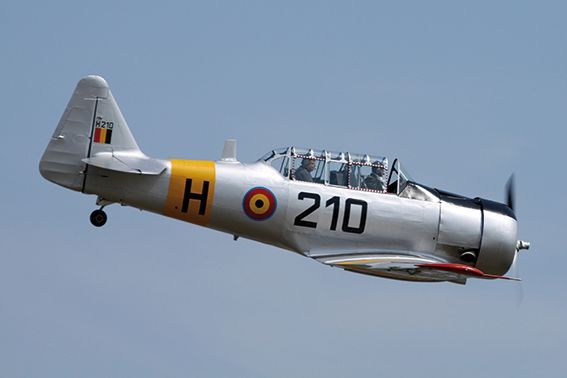
North American AT.6 Harvard
Thousands of copies of the North American T.6 Harvard were built and used by just about every air force in the world. The Belgian Air Force used this type for years for advanced flight training. After candidate pilots mastered the Stampe-Vertongen SV-4, training continued on the much heavier and more complex Harvard.
The one in our collection saw its military career with the South African Air Force. It came to our country about twenty years ago and has been on display in the museum ever since.
In 2011 it was repainted in FAF colours, the fire support flight of the Belgian Air Force, which operated in Congo during and after the independence period. The registration H210 refers to the aircraft with which Lt.-Vlieger Baudouin de Changy was active in that period. He rescued one of his crashed colleagues from enemy territory through a daring action, but was killed in another action a few days later.
To somewhat frame the events of 50 years ago, we hereby give a short description of this period, taken from “Diary of a FAF pilot” by Wilfried De Brouwer. The complete diary can be found on the internet. Thanks to Wilfried De Brouwer.
Following riots in Leopoldville (Kinshasa) at the end of 1959, the army command decided in early 1960 to arm a dozen Harvards based at Kamina with 4 .303 machine guns, launchers for 6 rockets and 2 attachment points for “General Purpose” bombs. The aircraft were divided into three support flights of four aircraft each, based in Kigali (Ruanda), Kindu and Kitona (Congo) and consisting of five pilots and six mechanics. The aircraft had lost some manoeuvrability due to their conversion. Wilfried was based in Congo in June 1960, and after a short conversion training he and some colleagues left for Kitona on 22 June.
Navigation flights were immediately carried out there, in order to get to know the environment as well as to familiarise the compatriots present on the plantations and in the settlements with the radio procedures.
On July 4, the first riots and mutinies were reported, followed by further mutinies and rapes. The mass evacuation of Europeans soon started. The FAF crews were put on standby. On July 11, orders were given to carry out some intimidation flights over Boma and Matadi. However, after seeing a flare, which was first seen as an intimidation attempt by the rebels, it turned out that Guy Depypere's H202 had crashed about 300m from the runway. With a second flare, the unfortunate pilot was able to signal his position and we realized that he was able to move and was on his way to the airfield. Getting help was difficult as our base was half an hour away by air and we had no radio contact with the Navy ships in the harbour. I was able to contact the wingman of the downed pilot, who would do the necessary at the base in Kitona. While on my way back to the crash site, I was told over the radio that my leader – Baudouin – had managed to pick up the pilot.
Baudouin had also noticed the second flare and, while Wilfried was trying to establish radio contact with the base and the third pilot, had landed at the airfield.
The rebels had emerged from the control tower, but fled back inside after the Harvard positioned itself in their direction and they saw the machine guns and missiles. The hapless pilot eventually emerged from the tall grass along the runway and struggled into the cockpit of the Harvard. Thumbs up and soon they were back in the air and on their way to base. This heroic attitude is unique in the history of the Belgian Air Force.
Upon returning to Kitona, our mechanics discovered bullet holes in each of the three remaining Harvards, clearly indicating that the Matadi area was anything but peaceful.
Baudouin would die a few days later when he tried to eliminate a machine gun nest on July 17. His aircraft, the H210, was shot down and, according to eyewitnesses, the pilot was killed with machetes by the rebels when he tried to climb out of the cockpit. His body was thrown to the crocodiles.
Stampe en Vertongen Museum vzw
Antwerp International Airport
Bus 3
B-2100 Antwerp-Deurne
Belgium
O.N. BE0447.236.613
RPR Antwerp
email: stampe@skynet.be
www.stampe.be
Opening hours individual visits
- Mon - Fri
- Closed
- Sat - Sun
- -
Closed on Easter Sunday and during August, December and January
Useful links
All rights reserved | Stampe en Vertongen Museum vzw






